There are so many different varieties of fava beans available today, and preparation techniques vary widely. It can be confusing! Fava beans can be purchased fresh in the pod, large and dried, small and dried, canned, frozen, or as a fresh sealed cold pack. My hope is that this post will answer all of your questions on how to prepare fava beans, so you can stop wondering and start eating.
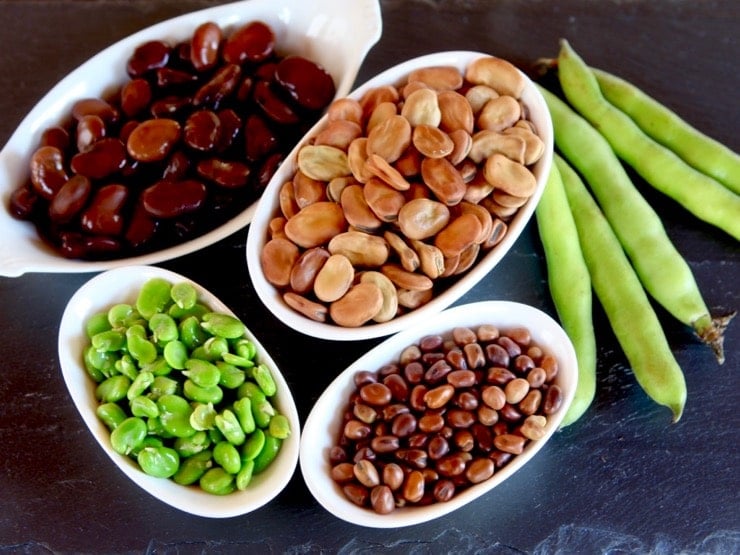
Fava beans are one of the oldest domesticated food legumes. References to favas occur in both the Talmud and the Mishna, indicating they have been part of the Middle Eastern diet since at least since the 4th century.
Tova Dickstein from Neot Kedumim Biblical Land Preserve in Israel once told me that fava beans were likely a main protein sources for the ancient Israelites. In fact, the ancient method for cooking fava beans is discussed in the Talmud. The dried beans were immersed in a pot of water, sealed, then buried beneath hot coals so they could slowly cook.
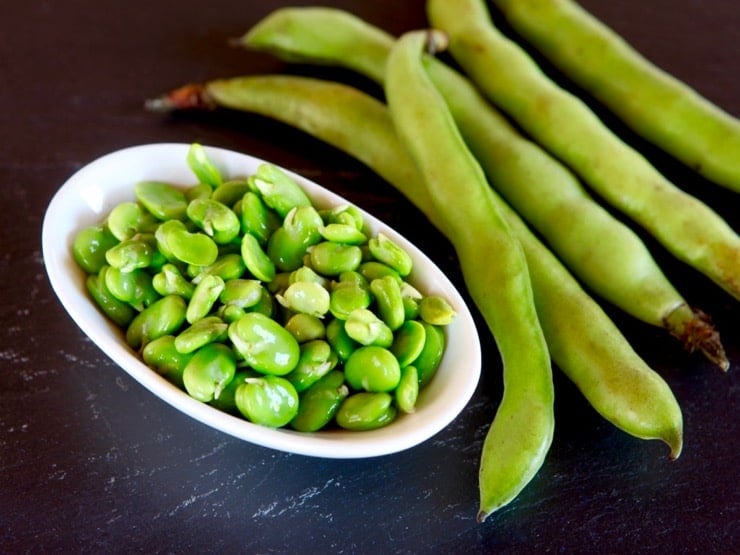
Beans are a great source of fiber, protein, fiber, iron, B vitamins, potassium, magnesium and many other beneficial nutrients. If you have never tried fresh fava beans, they’re really special– they have a mild, creamy flavor that compliments many spring dishes. Fresh from the pod they are bright green and very pretty. They have a short season, though. If you’re looking at making a fresh fava bean recipe outside of spring, your best bet is to use frozen fava beans or use fresh/frozen lima beans as a substitute. Lima beans are not the same as fava beans, but they are similar to fresh peeled and cooked fava beans.
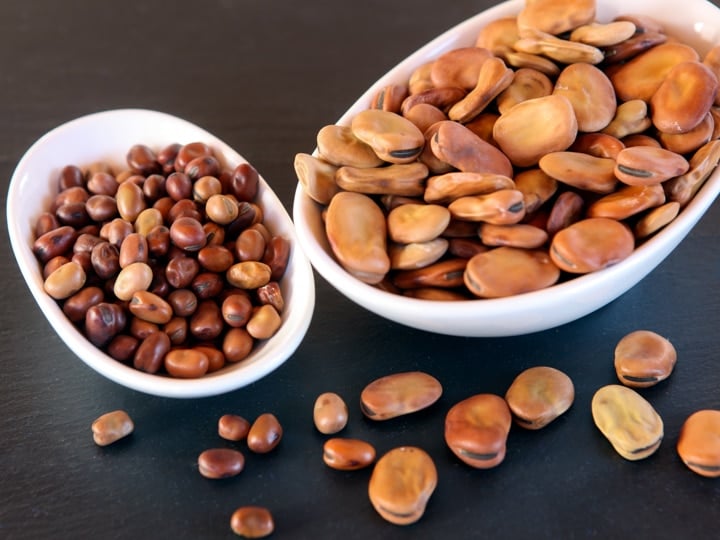
Dried fava beans, when cooked and peeled, have a texture similar to cooked chickpeas but slightly softer. Unlike fresh fava beans, dried can be enjoyed year-round. They are more economical than canned beans, and when you soak and cook them they do not contain unnecessary additives like sodium (plus you don’t have to worry about potentially toxic BPA can linings).
Most forms of fava beans need to be peeled before eating, unless they have already been prepped (which is sometimes the case with canned and cold packed beans). It’s a time-consuming process, but not difficult at all. I have outlined the peeling process below. Some people recommend leaving the shells on small dried fava beans after a long slow cook, but I find them to generally be quite tough and not great for eating. Depending on your usage, peeling is usually the way to go.
A quick but important note — fava beans are a trigger food for G6PD, a hereditary enzymatic deficiency. Those who have this deficiency can develop anemia (potentially severe) from eating fava beans. Populations with the highest percentage of people affected by the deficiency include Sephardic Jews and those of Mediterranean and African heritage. People who are diagnosed with G6PD should not consume fava beans, and if you ever experience symptoms or discomfort after eating them you should be tested for this genetic deficiency.
I hope this tutorial is helpful as you explore the wondrous world of fava beans! By the end you’ll be a fava bean master.
Hungry for more? Find me on Facebook, Twitter, Pinterest, YouTube and Instagram for all the latest updates!
Recommended Products:
We are a participant in the Amazon Services LLC Associates Program, an affiliate advertising program designed to provide a means for us to earn fees by linking to Amazon.com and affiliated sites. As an Amazon Associate I earn from qualifying purchases.
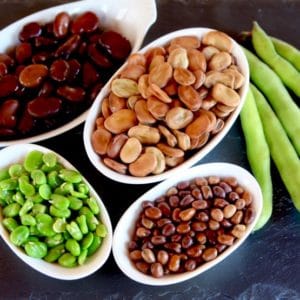
Fava Beans - How to Cook, Soak, Peel and Freeze
Ingredients
Ingredients to Prepare Fresh Fava Beans
- 2 pounds fresh fava beans in pods (please refer to instructions below if you plan to cook more or less)
Ingredients to Prepare Dried Fava Beans
- 1 pound large or small dried fava beans (please refer to instructions below if you plan to cook more or less)
- salt (optional)
NOTES
Instructions
TO PREPARE FRESH FAVA BEANS FROM THE POD:
- Fresh fava beans are large and come in a pod. The pod must be removed and the beans must be peeled to enjoy them in recipes.

- When you look at the fava bean pod, you will notice that the edges have a seam. To open the pod, snap off the tip and pull down; the seam will open like a zipper. If you have trouble "unzipping" the pod cleanly, don't worry. Once the pod is open at least somewhat you can easily tear it open the rest of the way with your hands.

- Remove the beans from the pod. Each pod should have 4 or 5 beans. You may want to collect them all in a bowl.

- When you are done, fill a mixing bowl with cold ice water (enough to cover the beans) and set aside. Then, fill a pot with water (enough to cover the beans) and bring to a boil. Once the water is boiling, blanch the fresh fava beans for 30 seconds.

- With a slotted spoon, immediately transfer the blanched fava beans to the bowl of ice water. This will stop them from cooking any longer.

- Your beans are now ready to peel. This is a bit time consuming, but the skins should slip off fairly easily by pinching between your thumb and forefinger.

- 2 pounds of fava bean pods will yield about 1 cup of blanched, shelled beans. Once the shells have been removed they will be quite tender. You can steam them longer to heat through, add them to salads, or use them in any recipe you like.

TO PREPARE LARGE DRIED FAVA BEANS:
- The method below uses a ratio of 10 cups of water per 1 pound of dried fava beans. If you plan to use a different amount, please adjust accordingly using this ratio. There are two ways to soak dried fava beans - either with an overnight soak, or with a shorter "quick soak."

- OVERNIGHT SOAK - in a large pot or bowl, combine the fava beans with water at a ratio of 10 cups of water per pound of dried beans. Soak overnight.

- Once the beans have soaked, you will notice that they have increased in size, indicating that they have absorbed moisture.

- QUICK SOAK - you will need 1 hour. Place the fava beans into the bottom of a large pot and cover with water. The beans will expand, so make sure you cover by several inches of water to allow for this. Bring beans to a boil. Let them boil for 3 minutes, then remove from heat.

- Allow the beans to soak in the hot water for 1 hour. After soaking using either method, drain and rinse the beans. Discard the soaking water.

- Peel the beans by squeezing each one between your thumb and forefinger. The skin should slip off easily. This step is time consuming, but a must for proper texture with the larger beans in particular (which have a very tough skin no matter how long you cook them).

- After peeling, you will need to continue cooking the peeled fava beans until tender. Place the beans in a large pot and cover again with the same ratio of fresh water (10 cups per pound of beans). It is important to use a fresh batch of water for cooking; the soaking water contains oligosaccharides, released from the beans during soaking, that can lead to digestive discomfort. Add salt to the fresh cooking water if desired to give the beans more flavor (I use about 1 tablespoon salt for every 10 cups of water). Place on the stovetop and bring to a boil, then reduce to a simmer. Simmer the beans until tender. This can take up to 45 minutes depending on the size of your beans. Test them every 10 minutes or so for doneness; when finished cooking they should be tender but not mushy.

- Drain the cooked peeled beans in a colander. Now your beans are ready to use.

TO PREPARE SMALL DRIED FAVA BEANS:
- The method below uses a ratio of 10 cups of water per 1 pound of dried fava beans. If you plan to use a different amount, please adjust accordingly using this ratio. There are two ways to soak dried fava beans - either with an overnight soak, or with a shorter "quick soak."

- OVERNIGHT SOAK - in a large pot or bowl, combine the fava beans with water at a ratio of 10 cups of water per pound of dried beans. Soak overnight.

- QUICK SOAK - you will need 1 hour. Place the fava beans into the bottom of a large pot and cover with water. The beans will expand, so make sure you cover by several inches of water to allow for this. Bring beans to a boil. Let them boil for 3 minutes, then remove from heat. Allow the beans to soak in the hot water for 1 hour.

- Once the beans have soaked, you will notice that they have increased in size, indicating that they have absorbed moisture. After soaking using either method, drain and rinse the beans.

- Place the beans in a large pot and cover again with the same ratio of fresh water (10 cups per pound of beans). It is important to use a fresh batch of water for cooking; the soaking water contains oligosaccharides, released from the beans during soaking, that can lead to digestive discomfort. Add salt to the fresh cooking water if desired to give the beans more flavor (I use about 1 tablespoon salt for every 10 cups of water). Place on the stovetop and bring to a boil, then reduce to a simmer. Cook the peeled fava beans until tender. This can take anywhere from 10-45 minutes depending on the size of your beans. Test them every 10 minutes or so for doneness by taking out a bean and slipping it out of its skin; the inner bean should be tender but not mushy. The smaller the beans, the faster they will cook.

- Generally these small beans will have a much improved textured after peeling, but very small dried fava beans may be eaten with skins on after a prolonged cooking process. I always cook then peel, but some recipes may specify cooking with skin on. If that's the case, prepare to cook for a long time-- it can take 2 hours or longer to soften those tough outer skins. If you're peeling them, they won't need nearly as long to cook because you'll be testing the inner bean for doneness, and not the tough skin.

- When the beans are tender, drain in a colander and rinse with cool water. If peeling the beans after cooking (my preference), you may remove the skins by squeezing the beans one-by-one between your thumb and forefinger. The skin should slip off easily. Discard the skins. Now your beans are ready to use.

TO FREEZE COOKED FAVA BEANS
- If you would like to freeze your fava beans for future use, first allow the beans to cool completely, then transfer them to a freezer safe container. I recommend resealable freezer bags, which you can place in the freezer until needed. I like to measure out 1 ¾ cups of beans in each bag, which is equivalent to the amount in a standard sized can. They will keep in the freezer for up to 6 months.

- When ready to use your frozen beans, remove them from the freezer and thaw. They can be reheated on the stovetop, added to soups and stews, or used however you would use canned beans.

Nutrition

tried this recipe?
Let us know in the comments!
Note: Nutrition information above refers to 1/4 lb. fresh shelled fava beans.
Fava Bean Recipe Ideas:
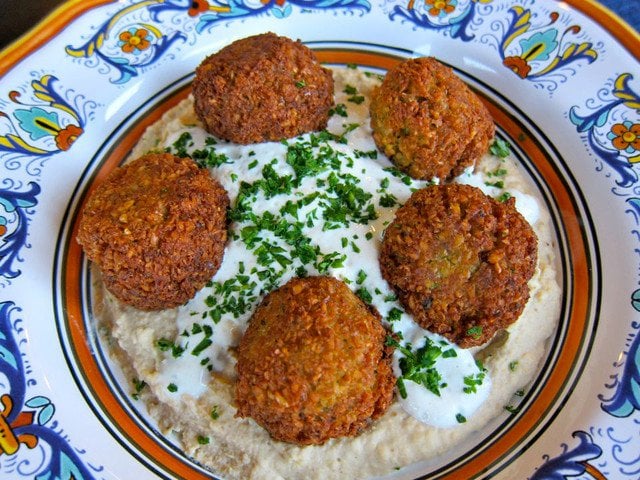
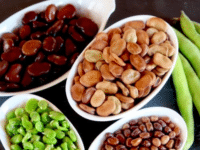
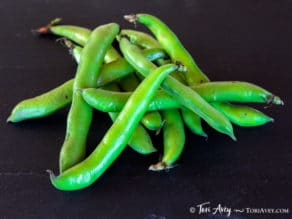
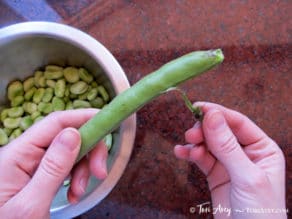
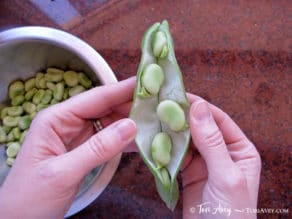
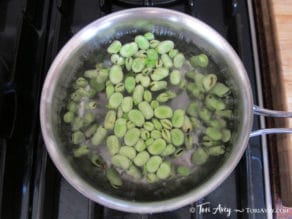
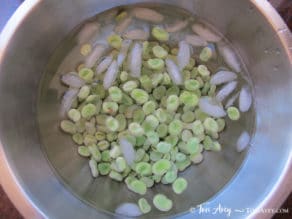
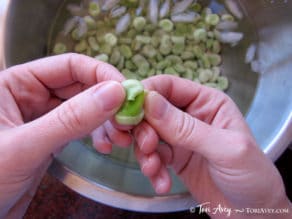
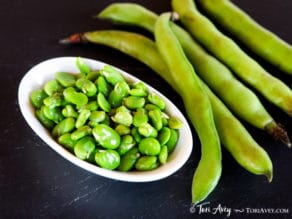
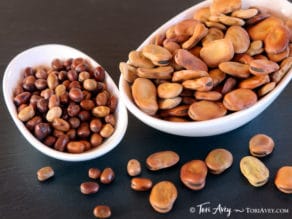
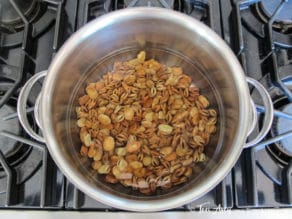
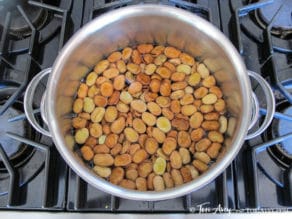
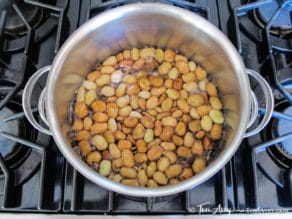
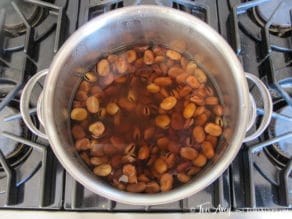
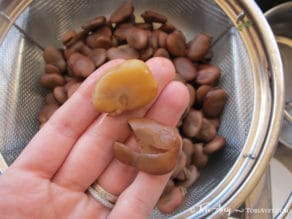
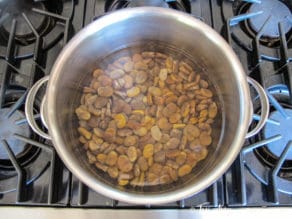
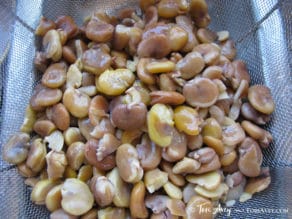
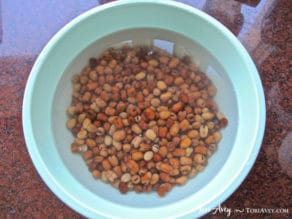
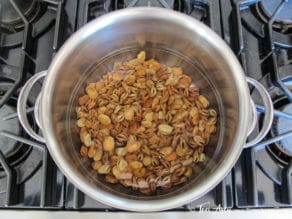
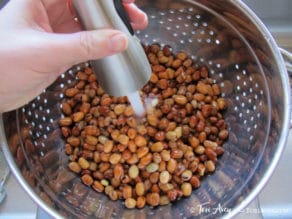
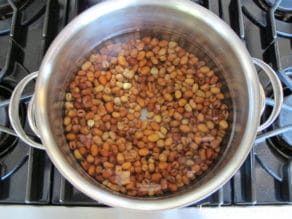
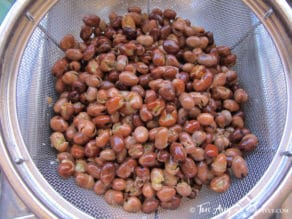
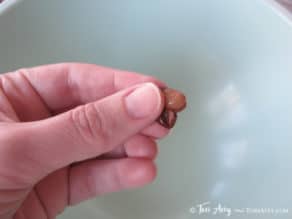

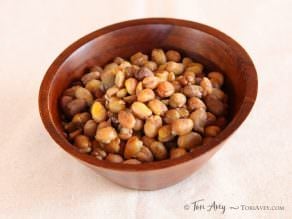
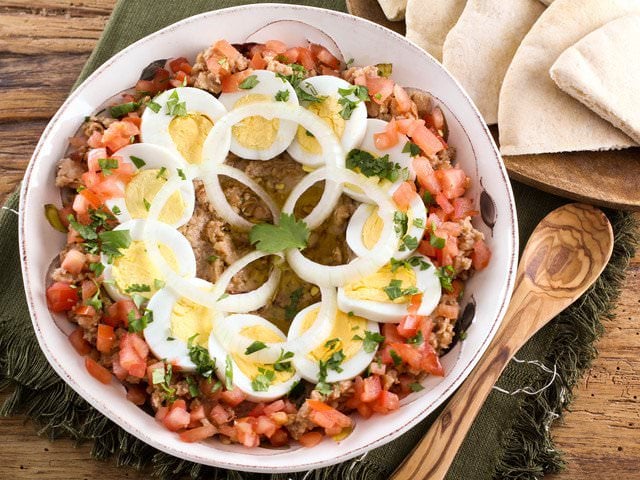


hello again.
i have been soaking these things for about 24 hours now and notice almost no difference.
i don’t know whether i should just let them soak for another night.
Are they large fava beans? Did you peel them? They won’t feel like they’re soaked until you peel them after soaking. The shell remains firm even after soaking.
thank you very much for this. i’m trying to reproduce a dish that used to be served by my favorite restaurant, which unfortunately closed recently. i bought some brown dried fava beans today and for now will try to soak about 2 ounces in about 1 1/2 cups of water overnight. i clicked on “print recipe” repeatedly but nothing happened and if i try to highlight and paste it will include the photographs so i may just try retyping the instructions.
Hi Carl, sorry to hear you’re having issues printing. Can you please let me know what device/browser you are using so I can help troubleshoot?
Thanks for the great article it is exactly what I was looking for. I am hoping to roast some Flava beans to make some snacks. Do you have any idea how I would do this?
Hi Lesley, when fava season rolls around again I will post a tutorial!
Thanks! Clear,concise and exactly what I was looking for 🙂
Hi
What can a do with a jar of fava beans? Ingredients are fava beans, water and salt. Do they have to be peeled?
Thanks
Sue
They probably don’t need to be peeled depending on the brand. I suggest making Ful Mudammas with them: https://toriavey.com/toris-kitchen/ful-mudammas-recipe/
Just what I was looking for! This tutorial was super helpful. Thanks!
I may have stumbled across a partial answer to removing skins from dried favas intended for purees (soups, hummus, etc.). After soaking and cooking overnight in my slow cooker, I ran them through my Victorio Strainer using the salsa screen and short spiral. Voila! A soft puree in one bowl and a much smaller bowl with the still-leathery skins. I think I may get an even nicer product with the smaller holes of the squash screen, will report if that turns out to be the case.
Love the Victorio strainer, a home gardener’s best friend in the fall!
Thank you Tori, for the excellent information on your site!
Dear Tori
Thank you so much for this comprehensive, easily understood, informative blog on Fava beans. I tried Fava beans (unsuccessfully) once before. I soaked and cooked them, and cooked them for what seemed forever. The skin was so tough. Didn’t try again.
Today I’m watching a TV program called ‘Chopped’. Oh yea! They were using Fava beans. During the tasting phase one of the judge’s criticism, to two of the cooks, was they’d not pealed the Fava beans! Say What? Grabbed my laptop, put the question in my browser and, POP, there you were. As I write this it’s midnight so I’ll have to wait until the stores open to buy Fava beans. I can hardly wait!
Awesome Libby! I knew this tutorial would be helpful– it is something I struggled with when I first learned to cook. It can be confusing with so many different types and methods! Glad it’s useful.
I’ve always eaten the skins, they really aren’t that tough. I know most people say to remove them but I really don’t understand why, especially with fresh ones.
It’s a texture thing, the skins are chewy and the beans are much more tender without.
Hi Tori! Thanks for sharing this recipe. What exactly are small fava beans? I’ve tried googling, but all I’ve found are regular fava beans. Also, what are some substitute legumes I could use in ful?
Hi Jonathan, small fava beans are simply smaller dried favas. Most fava beans that you find dried are about the size of a quarter. Small favas are also dried, and are the size of a dime or smaller. For a substitute in full mudammas, there really isn’t a great substitute. You can use chickpeas, but careful not to smash them too much or you’ll end up with hummus! Favas have a very unique flavor so if you can find them, best to use them for ful.
I would like to know, if you have a recipe for a fava bean soup? I do make pea soup, I could just add the fava bean instead of the pea to the soup. Love to try a new recipe for soups, especially on a cold raining day, with corn bread on the side! ARG
Not on the site, but it’s a great idea! Will keep it in mind now that fava season is here 🙂
Is that sodium correct? Other sites have it much lower so I am not sure if I can eat these or not. Thanks!
Hi Kate, no the value was not showing properly. I corrected it. Please note that the nutrition information you see above relates to fresh shelled fava beans.
Very interesting and helpful. Thank you. I will use the information the next time I cook fava beans.
Pressure cooking is the easiest way to cook them after soaking.
Even the skin is soft and you don’t have to peel the skin.
Pressure cooking time will be just 5 to 10 mins if soaked overnight.
thanks a lot. we always use a pressure cooker when we prepare beans and i will try that with my first attempt with fava beans.
This is the most comprehensive tutorial I found online! I was given dried fava beans from the farmer and I was so worried I would ruin the whole bucket as I had never seen (nor even cooked!) fava beans before. Thanks you so much for sharing your knowledge and experience with us ?
Thank you for this very comprehensive tutorial for fava beans, it’s the best one I’ve found online. Totally clarified the process for me.
I love ALL your recipes, thank you very much, I have been Muslim now since 1979, and I have 15 children and 17 grandchildren
All of this takes me back to when I was with all of my friends.??
Glad this was helpful to both of you!
I just found out that my family was Jewish before WW2 – most likely they changed to protect themselves. I wish they had not but it is the past but I am trying all of the foods that they would have eaten. This sounds like a good place to start
We have always eaten the pod of young fresh fava beans( known in Australia as broad beans). Cut the ends off and the string down the side . You leave each bean in the pod and cut straight through the pod so each bean has its own little compartment. Boil in a saucepan till cooked and eat! I love the pod.
Roasted, salted fava beans are available on nutsonline.com. I buy them there all the time. Great snack and very delicious! I would love to know how to make them myself.
Hi Tori,
Have you ever roasted and seasoned fava beans? Like to make like roasted peanuts as a snack? I would like to know if you could try and share this?
Shalom!
I have not, but I imagine it would probably work well with the bigger peeled beans – something akin to roasted crunchy chickpeas. I will keep it in mind for a future post! 🙂